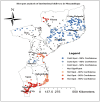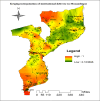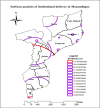Institutional delivery and its determinants among reproductive-age women in Mozambique: A geographic weighted regression
- PMID: 40875647
- PMCID: PMC12393721
- DOI: 10.1371/journal.pgph.0004520
Institutional delivery and its determinants among reproductive-age women in Mozambique: A geographic weighted regression
Abstract
Institutional delivery in Mozambique remains a critical public health issue. Despite efforts to improve maternal healthcare, many women still give birth at home. Moreover, the spatial pattern and spatial variables linked to institutional delivery in regions of Mozambique have not yet been discovered. Thus, this study aimed to explore the geographical variation of institutional delivery and its determinants among reproductive-age women living in Mozambique using geographically weighted regression analysis. The most recent Demographic and Health Survey data from Mozambique were used for secondary data analysis. In this study, a sample of 5,983 reproductive-age women in Mozambique was used. Data cleaning and preparation were conducted using STATA version 17 and Microsoft Excel. Global and local statistical analyses and mapping were conducted with ArcGIS version 10.7. In a Sat Scan analysis, a Bernoulli model was employed to identify the most likely spatial clusters of institutional delivery, while, spatial regression was analyzed using ordinary least squares regression and geographically weighted regression to predict hotspot area of institutional delivery. Model performance was assessed using corrected Akaike Information Criteria (AICc) and adjusted R2.The prevalence of institutional delivery in Mozambique was 65.41% (95%CI: 64.20, 66.61), and the spatial distribution of institutional delivery was clustered with global Moran's I = 0.479503. Getis-Ord analysis detected high institutional birth practice among women in Maputo, Maputo City, southwest Inhambane, central Sofala, southern Gaza, and western Niassa regions of Mozambique. Rich wealth index, unwanted pregnancy, vehicle transportation, and presence of skilled birth attendants significantly influenced institutional delivery in geographically weighted regression analysis.In Mozambique, over two-thirds of reproductive-age women delivered in health facilities, with high rates in specific regions such as Maputo city, southwest Inhambane, central Sofala, southern Gaza, and western Niassa. Key factors influencing institutional delivery included wealth, unwanted pregnancy, vehicle access, and skilled birth attendants.
Copyright: © 2025 Zegeye et al. This is an open access article distributed under the terms of the Creative Commons Attribution License, which permits unrestricted use, distribution, and reproduction in any medium, provided the original author and source are credited.
Conflict of interest statement
The authors have declared that no competing interests exist.
Figures








References
-
- Organization WH. WHO recommendations on intrapartum care for a positive childbirth experience. World Health Organization; 2018. - PubMed
-
- Yarinbab TE, Balcha SG. Delays in Utilization of Institutional Delivery Service and its Determinants in Yem Special Woreda, Southwest Ethiopia: Health Institution Based Cross-Sectional Study. J Gynecol Women’s Health. 2018;10(4):555793. doi: 10.19080/jgwh.2018.10.555793 - DOI
-
- Centers for Disease Control and Prevention. Pregnancy-related deaths. 2019. [cited 2020 Jan 15]. https://www.cdc.gov/reproductivehealth/maternal-mortality/index.html
-
- Trost S, et al. Pregnancy-related deaths: data from maternal mortality review committees in 36 US states, 2017–2019. Education. 2022;45(10):1–0.
LinkOut - more resources
Full Text Sources
Research Materials
